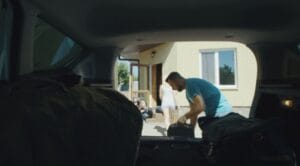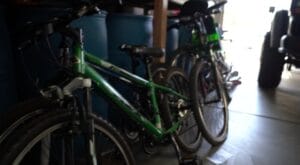- What to grab
- Transportation options
- Where to store items you’ll take
- Where to go
- Navigation
- Miscellaneous tips
What to grab
 Let us start off by saying that these items we’re about to recommend are what we consider the bare minimum. Maybe you have a different list of critical items and we would love to get your feedback as to what those are in the comments below, but if we knew we had a very limited amount of time, let’s say 5 to 10 minutes, these are the items we would recommend.
The first item is bug out bags. We’ve done several blogs on building bug out bags and we’ll post the newest below. In that blog, we walk you through all the major categories to consider when building your bag for both adults and children. Bug out bags serve an important role in providing you with the necessary items to keep you alive for 3 days. These bags have items ranging from shelter to food, and sleeping gear to communication devices. Again, we would refer you to that video for a more in-depth breakdown. It’s important that you have these bags on standby ready to go at a moment’s notice. Additionally, it’s important that you keep the following next to the bags:
Let us start off by saying that these items we’re about to recommend are what we consider the bare minimum. Maybe you have a different list of critical items and we would love to get your feedback as to what those are in the comments below, but if we knew we had a very limited amount of time, let’s say 5 to 10 minutes, these are the items we would recommend.
The first item is bug out bags. We’ve done several blogs on building bug out bags and we’ll post the newest below. In that blog, we walk you through all the major categories to consider when building your bag for both adults and children. Bug out bags serve an important role in providing you with the necessary items to keep you alive for 3 days. These bags have items ranging from shelter to food, and sleeping gear to communication devices. Again, we would refer you to that video for a more in-depth breakdown. It’s important that you have these bags on standby ready to go at a moment’s notice. Additionally, it’s important that you keep the following next to the bags:
- [Shoes or boots] with the socks inside
- [Clothes] you may not have time to get these out of your closet. Personally, we keep ours stored in our bug out bag for this very reason.
- [Water] We keep several 5 gallon water containers next to our bags that we can easily load into our vehicle.
- [Critical medicine] if you have medicine that you need to take, be sure to leave a note with your gear to grab it and where it is specifically located in your home should someone else have to grab your gear.
- [Important documents] either keep these in a safe next to your bug out bags or have a note detailing where they specifically are at in your house. A note about documents: We scan and keep ours stored in the cloud, using a service called Dropbox. You can also back up your data on a thumb drive. If you go this route, be sure to secure it with encryption or using biometric encryption.
- [Shelter] while our personal bug out bags have shelter included, we do not currently have a tent in our bags as our climate doesn’t necessarily require it. Obviously, modify that depending on your area. Nonetheless, we do keep a tent on standby to toss in the car with our bags.
- [Pets] it’s a good idea to keep their vaccination records with your other documents. Additionally, keep a leash and a few bags of food and a collapsible water bowl next to your gear to ensure they’re taken care of.
- [Security] when it comes to this item, we keep the necessary items in a vault next to our gear. Keep in mind that depending on the severity of the situation, local law enforcement will likely still be enforcing regulations or they may not even be present and security may fall on you. Plan accordingly.
- [Power production] this last item is optional but at some level should be given thought. Most of the electronics (flashlights, radios, etc) in our bags are rechargeable. We carry a small solar panel in our bags. As shown here, there are several options on the market and we’ll link to both of these below. They’re powerful enough to charge your smartphone or flashlights or a small battery. If you want something a bit more powerful, something like an Ecoflow Delta Max, Jackery, or any other product on the market will be helpful. If you’re shopping for these devices, we’ll provide a link to a recent, in-depth blog we just released which will help you if you’re in the market shopping for one of these devices.
Transportation options
 Let me start off by addressing the most common question: what is the best bug-out vehicle? The simple answer is: the one you have. For most people, there are 3 primary options.
The first and most important is some type of motorized vehicle everyone can get into quickly, such as a car, van, or truck. In our case, have a family mini-van and a 4×4 jeep. One pro-tip on your vehicle: get in the habit of keeping their gas tanks at least ½ full at a minimum at all times. For us, we’d load the critical gear in the Jeep first as it has the most options regarding where it could travel should the roads become jammed and we had to abandon our van. We’d take both vehicles to give us options. Remember, 2 is 1, and 1 is none.
The next is a bicycle or motorcycle. We personally don’t have a motorcycle, but they definitely provide you with a lot more options regarding the distance you can cover. For our family, we have bicycles for each family member and a bike rack that fits on the back of my Jeep. So should time permit, we would add these on the back of our Jeep. But if for whatever reason our vehicles were not an option, a bike is a great option as you can go places some vehicles simply can not. If you have a small child, make sure you have a small bike trailer or a seat on your bike for them. Speaking of bike trailers, these are great options for not only carrying a child but critical gear you may want to take. Bikes allow you to cover long distances with less effort than walking which is our final option…
Walking has its pros and cons. For pros: it allows you to go places neither a vehicle or bike can go. But the cons are plentiful: you can not cover as far as distance, if you’re not in shape or have an injury, this presents challenges, you’re exposed to the elements when compared to a vehicle, and the calories required to cover distances is great necessitating you carry more food and potentially water depending on your area. Speaking of which, having a cache of food, water, or other important gear along your bug out route could be critical to refuel you in the event you have to walk to your destination. We’ll post a link the cards above and in the description section which covers this in more detail.
Let me start off by addressing the most common question: what is the best bug-out vehicle? The simple answer is: the one you have. For most people, there are 3 primary options.
The first and most important is some type of motorized vehicle everyone can get into quickly, such as a car, van, or truck. In our case, have a family mini-van and a 4×4 jeep. One pro-tip on your vehicle: get in the habit of keeping their gas tanks at least ½ full at a minimum at all times. For us, we’d load the critical gear in the Jeep first as it has the most options regarding where it could travel should the roads become jammed and we had to abandon our van. We’d take both vehicles to give us options. Remember, 2 is 1, and 1 is none.
The next is a bicycle or motorcycle. We personally don’t have a motorcycle, but they definitely provide you with a lot more options regarding the distance you can cover. For our family, we have bicycles for each family member and a bike rack that fits on the back of my Jeep. So should time permit, we would add these on the back of our Jeep. But if for whatever reason our vehicles were not an option, a bike is a great option as you can go places some vehicles simply can not. If you have a small child, make sure you have a small bike trailer or a seat on your bike for them. Speaking of bike trailers, these are great options for not only carrying a child but critical gear you may want to take. Bikes allow you to cover long distances with less effort than walking which is our final option…
Walking has its pros and cons. For pros: it allows you to go places neither a vehicle or bike can go. But the cons are plentiful: you can not cover as far as distance, if you’re not in shape or have an injury, this presents challenges, you’re exposed to the elements when compared to a vehicle, and the calories required to cover distances is great necessitating you carry more food and potentially water depending on your area. Speaking of which, having a cache of food, water, or other important gear along your bug out route could be critical to refuel you in the event you have to walk to your destination. We’ll post a link the cards above and in the description section which covers this in more detail.
Where to store items to take
 There are a few main considerations when it comes to storing your gear:
There are a few main considerations when it comes to storing your gear:
- [Proximity to the exit] of your home, or more importantly, to your vehicles.
- [Temperature] of the area
- [Security and OPSEC]
Where to go
 It’s important that you define this in advance. If you bug out with no defined place to go, you’re a refugee. The most likely situation is that if you’re forced to flee, you’ll go to a friend or family member’s house. We would encourage you to have these items already defined on either a map or an app on your phone. When panic sets in and you’re fleeing a situation, you will very likely forget things that you once could rattle off the top of your head.
For some, heading to a hotel either in your city or outside might be your first option. We would encourage you to find a hotel that meets your specific needs in regards to cost or other important factors like whether they’ll accept animals or not if you have pets. Based on that, you may want to consider loading the hotel’s app on your phone with your credit card information already set up. Why? If there’s a disaster, it’s very likely that people will flood the hotel’s phone line to grab a room. If you’re already got your information stored with the hotel, hopping on an app and reserving your room will allow you to quickly lock in the confirmation.
Apart from going to a friend’s place or hotel, always have other options lined up in if staying in your local area is not a choice. We did a blog awhile back which we’ll link below that go over alternative bug out locations. We can’t emphasize this point enough: redundancy. Always, have a plan A, B, and C when it comes to where you’ll go if you’re forced from your home.
It’s important that you define this in advance. If you bug out with no defined place to go, you’re a refugee. The most likely situation is that if you’re forced to flee, you’ll go to a friend or family member’s house. We would encourage you to have these items already defined on either a map or an app on your phone. When panic sets in and you’re fleeing a situation, you will very likely forget things that you once could rattle off the top of your head.
For some, heading to a hotel either in your city or outside might be your first option. We would encourage you to find a hotel that meets your specific needs in regards to cost or other important factors like whether they’ll accept animals or not if you have pets. Based on that, you may want to consider loading the hotel’s app on your phone with your credit card information already set up. Why? If there’s a disaster, it’s very likely that people will flood the hotel’s phone line to grab a room. If you’re already got your information stored with the hotel, hopping on an app and reserving your room will allow you to quickly lock in the confirmation.
Apart from going to a friend’s place or hotel, always have other options lined up in if staying in your local area is not a choice. We did a blog awhile back which we’ll link below that go over alternative bug out locations. We can’t emphasize this point enough: redundancy. Always, have a plan A, B, and C when it comes to where you’ll go if you’re forced from your home.
Navigation
 When it comes to navigation, let’s be honest, most of us are used to pulling up an app on our phone. There’s nothing wrong with this and we’ll discuss a few important apps in a moment, but remember, our phone and other devices rely upon satellites to power our GPS devices. A solar flare, coronal mass ejection, EMP, or some other type of event could render these useless.
When it comes to our phones, most are probably familiar with apps like Google maps, Waze, or Gaia GPS. These apps can work if there’s no internet or phone service. Your phone can still connect to satellites to determine your location via the GPS receiver in your phone. If you have the map downloaded in these apps but the internet is not available, you’ll still be able to determine your location. You would be wise to download the map that is the area between your home and the places you would want to head to.
Let’s talk about Google maps first as it is probably the most popular. If you hop over to Google and type in “How to download google offline maps”, Google provides step by step instructions. Again, as we just mentioned, you can use Google maps even if there’s no internet connection for areas that you have downloaded before the internet goes offline.
The 2 other apps we referenced, Waze and Gaia maps are both popular apps which like Google allows you to download the maps in advance. Of all the apps we’ve referenced here, we would highly recommend Gaia. Our Scout troop uses this for hiking and there’s a paid version if you want more features. We often use this app when off-roading by downloading the map of the area we’ll be covering in advance.
One device we often reference on this channel is the Garmin inReach mini. These aren’t cheap, but they’re packed with several unique features. Like the apps referenced earlier, you can download an app on your phone and then download maps to the app and this device via bluetooth will sync to your phone so you can see your movements on the app. Obviously, the other apps we just covered a moment ago can do the same via the GPS tracker built into your phone, but the most unique feature is that you can send and receive text messages via satellite with this device. So if the internet in your area is completely down and you need to communicate outside, this is the way to go.
The last option on this point is a simple map and compass. We did a blog a little over a year ago which covered the basics of this and we’ll link to it below. If you don’t already have a simple compass, they’re honestly not that expensive. When it comes to maps, you definitely need to get a local map. And by local, we don’t just mean a state map, but a map of your city and surrounding area. You can typically pick these up at your local AAA office locations. Have routes already marked and locations you want to go to. It’s best that you define alternative routes as the main roads will very likely be blocked by heavy traffic if everyone else tries to evacuate at the same time.
When it comes to navigation, let’s be honest, most of us are used to pulling up an app on our phone. There’s nothing wrong with this and we’ll discuss a few important apps in a moment, but remember, our phone and other devices rely upon satellites to power our GPS devices. A solar flare, coronal mass ejection, EMP, or some other type of event could render these useless.
When it comes to our phones, most are probably familiar with apps like Google maps, Waze, or Gaia GPS. These apps can work if there’s no internet or phone service. Your phone can still connect to satellites to determine your location via the GPS receiver in your phone. If you have the map downloaded in these apps but the internet is not available, you’ll still be able to determine your location. You would be wise to download the map that is the area between your home and the places you would want to head to.
Let’s talk about Google maps first as it is probably the most popular. If you hop over to Google and type in “How to download google offline maps”, Google provides step by step instructions. Again, as we just mentioned, you can use Google maps even if there’s no internet connection for areas that you have downloaded before the internet goes offline.
The 2 other apps we referenced, Waze and Gaia maps are both popular apps which like Google allows you to download the maps in advance. Of all the apps we’ve referenced here, we would highly recommend Gaia. Our Scout troop uses this for hiking and there’s a paid version if you want more features. We often use this app when off-roading by downloading the map of the area we’ll be covering in advance.
One device we often reference on this channel is the Garmin inReach mini. These aren’t cheap, but they’re packed with several unique features. Like the apps referenced earlier, you can download an app on your phone and then download maps to the app and this device via bluetooth will sync to your phone so you can see your movements on the app. Obviously, the other apps we just covered a moment ago can do the same via the GPS tracker built into your phone, but the most unique feature is that you can send and receive text messages via satellite with this device. So if the internet in your area is completely down and you need to communicate outside, this is the way to go.
The last option on this point is a simple map and compass. We did a blog a little over a year ago which covered the basics of this and we’ll link to it below. If you don’t already have a simple compass, they’re honestly not that expensive. When it comes to maps, you definitely need to get a local map. And by local, we don’t just mean a state map, but a map of your city and surrounding area. You can typically pick these up at your local AAA office locations. Have routes already marked and locations you want to go to. It’s best that you define alternative routes as the main roads will very likely be blocked by heavy traffic if everyone else tries to evacuate at the same time.
Timing
 Timing is everything. It’s very likely that unless you have some way to determine an incident before it happens, you will be unable to beat traffic and there’s a strong possibility you might get stuck in heavy traffic depending on your location, especially if you live in an urban or suburban area. Having said that, by having your gear ready to go on a moment’s notice, you do give yourself an advantage of heading out while the masses are trying to get their stuff together. So being prepared not only ensures you’re not caught unaware, but it also allows you to move faster before everyone else. When every second counts, being prepared makes a big difference.
If for whatever reason you do not make it out before the masses, having alternative routes defined in advance will be even more important. We decided to go with a 4×4 for this very reason and carrying bikes on the rack on the back of my Jeep gives us options if we have to abandon our vehicles.
Timing is everything. It’s very likely that unless you have some way to determine an incident before it happens, you will be unable to beat traffic and there’s a strong possibility you might get stuck in heavy traffic depending on your location, especially if you live in an urban or suburban area. Having said that, by having your gear ready to go on a moment’s notice, you do give yourself an advantage of heading out while the masses are trying to get their stuff together. So being prepared not only ensures you’re not caught unaware, but it also allows you to move faster before everyone else. When every second counts, being prepared makes a big difference.
If for whatever reason you do not make it out before the masses, having alternative routes defined in advance will be even more important. We decided to go with a 4×4 for this very reason and carrying bikes on the rack on the back of my Jeep gives us options if we have to abandon our vehicles.
Conclusion
Remember, when disasters happen, having a plan A, B, and C is important. You may have heard the quote from Mike Tyson, “everyone has a plan until they get punched in the mouth” or you may have heard the military strategist statement, “no plan survives first contact with the enemy”. When approaching the concept of bugging out, you must be flexible. While planning is incredibly important, things will likely go wrong but adaptability will be crucial. Again, we’ll post a link to a blog that covers the subject of bug out locations in more detail below, so be sure to stick around to read that. Additionally, be sure to check out the bug out guide which we’ll post a link below. If you have any feedback or any comments, feel free to share this with the community. As always, stay safe out there. Description section links 1) What to Grab- Bug out bags: see a video detailing this here: https://www.youtube.com/watch?v=zhP4KWryWhc

